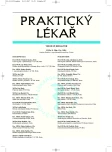Influence of frequent upper respiratory infections on the occurrence of thyroid gland diseases – a comparison with general population
Authors:
J. Bednářová 1; V. Zamrazil 2
Authors‘ workplace:
Katedra antropologie Přírodovědecké fakulty Univerzity Karlovy, Praha
Vedoucí: prof. RNDr. Václav Šmahel, CSc.
1; Endokrinologický ústav, Praha
Ředitel: doc. MUDr. Vojtěch Hainer, CSc.
2
Published in:
Prakt. Lék. 2007; 87(12): 724-726
Category:
Of different specialties
Overview
This study involved 364 patients from the endocrinology out-patient clinic undergoing treatment for thyroid gland disease for varying lengths of time (the total number of individuals under medical treatment was about 1 500 and all of them were requested to respond). The goal of the study was to find out whether there is a casual nexus between frequent and repeated inflammation of the upper respiratory system and thyroid disease. All of the patients’ ailments were recorded. The method of open and closed questions was employed. To better evaluate the results, the patients were subsequently divided based on their own statements into: euphuistic thyroid, inflammation, hypothyreosis, hyperthyroidism, tumour and operation (in the course of processing the results the single successive pairs of diseases were put together because of the low presence of some of them in the study group). The study also found that almost one fifth of the patients asked did not know which kind disease they actually suffered from. This finding was immediately put to the head of the department who promised improvements aimed at the best possible patient awareness.
Key words:
upper respiratory tract infections, thyroid gland disease, disturbances of endocrine function, tumours, operations.
Labels
General practitioner for children and adolescents General practitioner for adultsArticle was published in
General Practitioner

2007 Issue 12
Most read in this issue
- Functional systems of the human brain
- Laparoscopic cholecystectomy for cholecystolithiasis and its complications. Retrospective 1-year analysis of 411 patients
- Intestinal tapeworms. Do they still exist? Are they still able to surprise us?
- Typical and atypical forms of Celiac disease in adults
